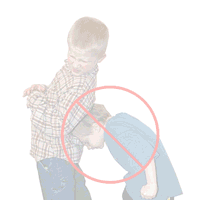
voice (603)
924-1321
fax (888) 777-0875
toll-free (888) 777-0876
Quality Software and Related Products for Visual Learners since 1998
 |
Ideas to help you turn tears into smiles |
Simple Solutions to Common Autism Problems
Using our Picture This... flashcard software, you can easily create simple visual solutions to many of the basic problems faced by autistic and special needs individuals. Many of the typical problems and solutions are discussed below.
Tantrums / Disruptive Behaviors
If you live or work with an autistic individual, you certainly are aware that people on the autistic spectrum are professional tantrumers - capable of turning heads in busy shopping malls or being heard far down the school hall.
One of the keys to stopping tantrums and disruptive behavior is identifying the following:- What caused the tantrum or behavior? (Antecedent)
- What behavior occurred?
- What was the consequence of the behavior?
- What was the duration of the behavior?
Here are some common causes of tantrums or disruptive behavior:
- Uncomfortable environment
- Task Avoidance
- Inability to express basic needs
Remember to evaluate the environment from the individual's perspective. For example, a grocery store is not overwhelming to you, but the noise of clanging shopping carts, screaming babies and fluorescent lights can be very overwhelming to an autistic person.
For example, if a math problem is too difficult, a student may start screaming and throw the paper on the floor.
Think about how you would feel if you were traveling in a foreign country where you couldn't understand the language. If you really needed to find a restroom, but no one understood what you were saying, you might consider having a meltdown yourself. This is how many nonverbal autistic individuals feel constantly.
Once you have determined the cause of a tantrum or inappropriate behavior, you should note exactly what occurred as a result of the behavior. For example, in the task avoidance example above, if the teacher does not analyze the situation properly, she may put the student into timeout for his disruptive behavior. Unfortunately, the student gets exactly what he wanted - no math problems. The next time that the student is presented with a math problem, he will probably begin to tantrum immediately.
Noting the duration of the behavior will help you to determine if the situation is getting better or worse. Before the behavior is completely extinguished, it should get much worse, peak, and then extinguish itself. This is called an extinction burst.
Possible solutions to extinguishing tantrums / inappropriate behaviors
- Use Photos to Communicate about the Uncomfortable Environment
- Use Token Boards to Keep a Student Motivated
Just like the person who wants to know when he will be getting out of the grocery store, a student would like to know when he will be done with his dreaded math work. Even though you may verbally say that he only has to do 10 problems, he may not understand you or be able to remember how many problems to do. An easy way to solve this situation is to make a token board. These boards show exactly how much work needs to be done, and what the student can do when he finishes
- Use Photo Choice Boards for Indicating Basic Needs
Ideally an autistic individual should have some means of expressing his discomfort besides tantruming. One easy way to provide a communication system for the autistic individual is to print some basic communication cards using our Picture This... CDs. For example, you could print a picture of a screaming baby, or a picture of ears to indicate that the environment was too loud. The autistic individual could carry the cards in a small photo album and point to the picture to indicate what is bothering him.
The autistic person will also probably be much calmer if he knows when he will be getting out of the unpleasant situation. Say for example, that you need to buy 5 items. You can use Picture This... to print these five items in a row on a piece of paper. At the end of the row, you can either show a picture of the car or a treat that the person will receive. As you put each item into your cart, cross the item off and say "just ___ more items before we go to the car". Knowing that he will not be stuck in the grocery store for the rest of his life should really ease the autistic individual's anxiety.
Our Picture This... CDs have over 3000 photos which you can use to make choice boards or augmentative communication cards for special needs individuals. To make a simple board, print out 2 inch by 2 inch photos of your child's favorite foods. For example, juice, banana, chicken nuggets and fries. Laminate these pictures and stick a magnet or piece of velcro onto the back of each card. Stick the four pictures onto a board or the refrigerator. Teach your child to point to what he needs. This will prevent tantrums, and everyone should be much happier!
Using Behavioral Photos to Model Appropriate Behaviors
Because autistic individuals are visual learners and have a difficult time processing spoken language, they may not understand when you say "don't yell". First of all, they often do not understand negatives like "don't", "not" and "no". When you say "don't yell", they hear "yell" and are more than happy to do that. To help show them what they should and should not do, we suggest that you print some behavioral rules photos. Print only the negative behaviors that they already do. They don't need to pick up any more bad habits! Make sure to keep the photos with you when you go out in public, and also post them in the appropriate spots around the house. For example, if your child always yells while watching TV, try putting a "no yelling" photo next to the TV. You will probably also want to put a "no rewinding" photo next to the VCR also!

Autism Solutions